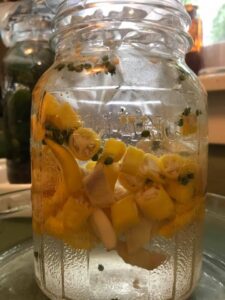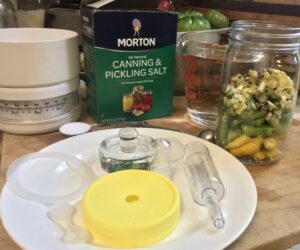
I harvested the last peppers from my garden two weeks ago. Earlier this Spring, the stellar staff at Naomi’s Organic Garden Supply recommended a yellow chili pepper varietal that I planned to use in ferments. Sarit Gat, a slim, yellow, hot chili from Kosovo and a steady producer, provided colorful heat to my spicy dill pickles and was intended to become a base for fermented hot sauce.

I’d planned on pairing it with the seemingly ever present green coriander seeds in the garden, along with ginger and garlic. I congratulated myself on planning holiday gifts while purchasing the seeds last February. *pat on the back*
Well…my first two batches failed. I wasn’t alone. Friends reported that their sauerkraut or pickles weren’t bubbling and were way too salty.

Image buy Buffy Rhoades
Failed batches are a learning opportunity, but we were following tested recipes, so I wasn’t sure what went wrong. Did any of you have issues with your ferments being too salty this year? Did Kahm yeast, that white film that ruins the flavor of ferments, colonize in your jars? Raise your hand if that happened to you too. *hand raised*
It’s important to understand how fermentation occurs so you can learn from your experiences. The subject of fermentation is diverse (pickles, wet-brine, dry-brine, vinegar, wine, beer, kombucha, sourdough, yogurt, cheese, charcuterie…) and is well covered by knowledgeable authors of famous books and university publications that provide step-by-step instructions, equipment recommendations, and trouble-shooting help.

Image from Buffy Rhoades
We can’t review all these topics in one post, but will dig deeper in the future. (My friend, Kristina, is recommending a multi-part series to cover this topic.) Let me know if you’re interested in more fermenting content. For now, let’s take a look at evaluating pickles, kimchi, and sauerkraut.
This may be putting the cart before the horse, but understanding the principles- the How It Works and Why We Do What We Do- can help you answer your own questions during the process. Every batch, every season, is different and knowing how to respond to this living project may be helpful as you get started.
So this is the low-down:

Image by Buffy Rhoades
Salt: It creates a beneficial environment for certain bacteria to grow and discourages growth of undesirable bacteria. It’s used to pull liquid from vegetables when dry-salting, a technique used when making sauerkraut, or as a brine to submerge vegetables, such as when making pickles. Only use pickling/canning salt, as not all salts are the same weight by volume and recipes are tested use this salt. It’s also free of additives.
Containers: Glass, food-grade plastic, and ceramic is okay. Avoid metal clasp-top lids because the acidity you’re striving for will eventually ruin them. I like glass containers because the tiny bubbles show active fermenting and I can see if all the bubbles have been released daily. Quart and half-gallon jars are great; place on a non-metal plate or pie tin to catch drips.

Weights: You need something to keep your fermenting ingredients under liquid. This can be easier said than done, as little wispy things like to float. It’s important though, because fermentation bacteria thrive in anaerobic (air-free) environments. Large cabbage leaves or even a couple onion slices can act as the first layer to corral small vegetables or spices. You can go low-tech and use a zip-close bag or jelly jar filled with brine (or jelly), or ceramic or glass weights. I have zero luck using a plate. If it works for you… awesome-sauce. Please tell me what you do in the comments. FYI, The Joy of Pickling suggests using brine instead of water, just in case the bag leaks or the jar spills in your product. By the way, it’s not a matter of if it will leak. It’s a matter of when.

Photo by Buffy Rhoades
Temperature: This is pretty cool to know. As a general rule of thumb, a slow ferment produces the most interesting flavor. The beginning bacteria like to start out around 60F and 72F. Too low and they have a hard time waking up. Temps higher than 80F and they’re likely to be soft and can skyrocket into what I think of as the Fast Track lactobacillus and can become very acidic, but not have much depth of flavor. Temps over 90F can result in rotting. Sometimes low temps are a good thing, like if you’re going away for the weekend and have no one to babysit your batch, you can pop it in the fridge, but is not ideal at the beginning of your ferment or for long term storage.

by Shirley J. VanGarde and Margy Woodburn
What’s Happening In There? The initial fermenters, the first bacteria, are naturally present on the surface of the vegetables. (Yes, you should still wash the veggies before starting.) Salt, water, temperature, and providing an anaerobic environment help them outgrow the competition. They consume carbohydrates and convert them to acid. That conversion creates a new, optimum (acidic), environment for the next set of microbes, and so on. As they expire, they release gas (CO2) resulting in bubbles.
Managing Brine: Now listen, this is important. Brine is not just salt water. Its the juices pulled from your vegetables. It’s the accumulation of different bacteria converting sugar to acid. It’s valuable stuff. It evolves with your vegetables. When your product is full of bubbles, don’t let them just sit there. Gently shake them out. They create pockets of air, something we want to avoid. Plus it’s a fun way to start the morning. Either way, you don’t want to lose this stuff. (Unless it’s thick and slimy, in which case you toss the contents, note what you did wrong and start over.) Which brings me to the major reason for loss of brine…

Headspace: Do not overfill the jar or container. It can be tempting to add “just a little bit more” to a nearly full jar. Please, I beg of you, learn from me and don’t do it. As your ferment becomes more active, it will overflow and if you’ve overfilled the jar, you’ll lose that valuable brine. (This is where the non-reactive plate or pie pan comes in handy.) Some overflow is natural and to be expected, but you don’t want to lose so much that you don’t have enough to cover your ingredients. When this happened I tried to push it down. Guess what. It didn’t work. I had to remove some kraut. Adding new brine at this point is too late, because the microbes have been hard at work creating a whole new environment. I called that failure a “teachable moment.”
Recipes: This is where the proverbial rubber meets the road. Imagine growing peppers from seed and reserved limited garden space to let your coriander plants go to seed, but for some reason used an untested recipe and, instead of fermenting, it became a salty host for Kahm yeast. Do yourself a favor, save time, money, and effort and use extension resources. OSU Extension’s Pickling Vegetables publication is a great place to start!

Now What Do I Do? If left under the same conditions, your product will continue to ferment, but will move beyond peak quality and begin to deteriorate. You have a couple of options:
- Store in the fridge. Eat it. Gift it. It’ll be at peak flavor and texture for about 6-9 months, depending on the temperature of your fridge, but will be fine for about a year. The color will fade and texture will become softer but it won’t be unsafe. Depending on how many ferments you have, this may take up a substantial amount of fridge space. Plan accordingly 🙂
- Preserve: If you eat fermented foods for its probiotic benefits, you won’t be interested in canning your sauerkraut, as it kills the probiotics. But did you know it’s possible to do so? If you decide to Boiling Water Can fermented pickles, the National Center for Home Food Preservation, OSU’s Pickling Vegetables, and other university publications have recipes to safely do so. Half-fermented products, like half-sours, cannot be processed because they haven’t developed the acid necessary to make it a safe product. Also, fully fermented pickles made from a tested recipe can be safely processed using Low Temperature Pasteurization, if indicated in the recipe.
With guidance from OSU Extension and Master Food Preserver Volunteer Program, I learned the science behind fermentation and gained confidence from my amazing teachers, but still make mistakes. We talk them over, share ideas, experiences, theories and learn from each other. In hindsight, I should have sanitized my equipment, since Kahm yeast likes to stick around a while. I managed to save the failed peppers by rinsing them and applying different preservation techniques. One batch went into the dehydrator to become powder, using the technique mentioned in Tomatoes and Autumn Sweaters, and the other batch is in 5% strength apple cider vinegar. It smells amazing and is nicely spicy. I see pickled onions in my future!

Image by Buffy Rhoades
Don’t be discouraged by failure. If we’re lucky, we learn from it, right?
Until next time friends… please comment, share, and visit the OSU Extension Clackamas County Family and Community Health (FCH) program’s Facebook and Instagram pages, learn new skills on our YouTube channel, read the latest installment of holiday topics in our newsletter, Healthy Together, and more on our website.